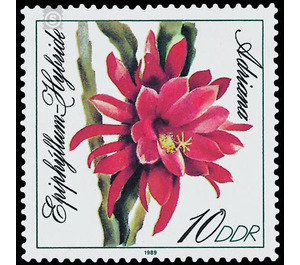Leaf cactus varieties - Germany / German Democratic Republic 1989 - 10 Pfennig
Theme: Flora
| Country | Germany / German Democratic Republic |
| Issue Date | 1989 |
| Face Value | 10.00 |
| Color | multi-colored |
| Perforation | K 13 |
| Printing Type | offset |
| Stamp Type | Postage stamp |
| Item Type | Stamp |
| Chronological Issue Number | 3018 |
| Chronological Chapter | GER-DDR |
| SID | 971442 |
| In 15 Wishlists | |
Blattkakteenzüchtungen The Ministry of Posts and Telecommunications of the German Democratic Republic publishes three multicolored special postage stamps with pictures of leaf cactus varieties. Special cancellations from September 19 to November 18, 1989 Leaf cactus varieties The term phyllocacti (or leaf cacti) has almost disappeared from general vocabulary in recent decades. Very few plant friends know that behind this name hides one of the largest hybrid genera of the plant kingdom, which includes about 10,000 registered varieties. Leaf cactuses are among the plant species most cultivated in breeding. What are "phyllos"? Their ancestors are the botanical epiphyls, mostly white nightblüten, from the tropical rainforests of America, which came to Europe at the beginning of the 19th century. It was German gardeners who devoted themselves to the cultivation of beautiful varieties around 1890. Names such as Johannes Nicolai (1860-1901, Dresden), Georg Bornemann (1862-1920, Blankenburg / Harz), Curt Knebel (1871-1954, Erlau / Sachs.) And Walther Haage (born 1899 Erfurt) are still in the Technical literature a concept. With the present special postage stamps the breeding work of this diligent gardener is to be honored. 10 Pfennig value: Adriana "Adriana" was released in the mid-50s by Walther Haage. This healthy, vigorous variety is a reliable bloomer and is exceptionally appealing due to its bizarre flower shape. Unfortunately, the tragic events of the Second World War, with its dreadful effects, cast its shadow over this branch of ornamental plant nursery. While only individual varieties of Johannes Nicolai outlasted both world wars, Curt Gnebel and Walther Haage were already severely impaired in their breeding work due to the vegetable cultivation commitments, bomb effects and fuel shortages. Representing many beautiful others, the present three flowers may be a memorial to the pioneers of this breeding work.


